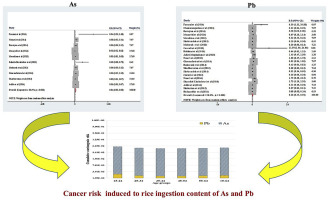Food and Chemical Toxicology ( IF 3.9 ) Pub Date : 2018-01-16 , DOI: 10.1016/j.fct.2018.01.018 Yadolah Fakhri , Geir Bjørklund , Anoushiravan Mohseni Bandpei , Salvatore Chirumbolo , Hassan Keramati , Rokhsane Hosseini Pouya , Anvar Asadi , Nazak Amanidaz , Mansour Sarafraz , Amir Sheikhmohammad , Mohamadreza Alipour , Zahra Baninameh , Seyed Mohsen Mohseni , Maryam Sarkhosh , Seyed Mehdi Ghasemi

|
Exposure to heavy metals such as arsenic (As), lead (Pb), and cadmium (Cd) in either the short or the long term can cause cancers in humans. Dietary intake and consumption of rice (Oryza sativa L.) is increasing in Iran, and several studies on the concentration of heavy metals in rice have been carried out in this country in recent years. In this perspective, the main objective of the present study was to investigate, even via a meta-analysis of the existing literature, the presence of As and Pb in rice from many geographical areas in Iran, as well as to estimate the carcinogenic risk of these heavy metals in rice consumers. The results of the present ten years-spanning systematic review indicate that 21 reports, collecting a total of 2088 samples, were performed between 2008 and October 2017. The minimum and maximum concentration of As was observed in the Golestan area (0.01 ± 0.01 mg/kg d.w) and the Gillan region (3 mg/kg d.w); and Pb in the Shahrekord (0.07 ± 0.02 mg/kg d.w) and Mazandaran (35 mg/kg d.w). The meta-analysis of data showed that pooled concentration of As in the rice was 0.04 (95%CI: 0.02–0.06 mg/kg d.w), which resulted lower than the National Standard (NS) limits. However, the pooled concentration of Pb in the rice was 0.38 (95%CI: 0.25–0.5 mg/kg d.w), i.e., higher than NS limits. The heterogeneity was significant between As (I2 = 63%, P value = .003) and Pb (I2 = 96%, P value < .001) studies. The carcinogenic risk assessment showed that minimum and maximum incremental lifetime cancer risk (ILCR) of As was in the 45–54 (4.53 × 10−2) and 15–24 (5.50 × 10−2) year age groups consumers; and Pb, 45–54 (2.442 × 10−3) and 15–24 (2.96 × 10−3), respectively. The overall carcinogenesis risk of As (4.864 × 10−2) was 18.5 times higher than Pb (2.623 × 10−3). All age groups consumers of rice content of As and Pb are at considerable carcinogenesis risk (ILCR > 10−3). Therefore a decreased level of heavy metals in rice cultivation should be encouraged and performed in next planning.
中文翻译:

伊朗大米(Oryza sativa L.)中砷和铅的浓度:系统评价和致癌风险评估
短期或长期暴露于重金属如砷(As),铅(Pb)和镉(Cd)会导致人类癌症。膳食摄入量和大米的消费(水稻L.)在伊朗正在增加,近年来,该国已对稻米中的重金属浓度进行了几项研究。从这个角度出发,本研究的主要目的是通过对现有文献的荟萃分析,调查伊朗许多地理区域的大米中砷和铅的存在,并评估其致癌风险。大米消费者中的这些重金属。本十年跨度系统审查的结果表明,在2008年至2017年10月之间进行了21份报告,共收集了2088个样品。在Golestan地区观察到的最低和最高As浓度(0.01±0.01 mg / kg dw)和吉兰地区(3 mg / kg dw);和Shahrekord(0.07±0.02 mg / kg dw)和Mazandaran(35 mg / kg dw)中的Pb。数据的荟萃分析表明,水稻中砷的总浓度为0.04(95%CI:0.02–0.06 mg / kg dw),这低于国家标准(NS)的限值。但是,大米中铅的合并浓度为0.38(95%CI:0.25-0.5 mg / kg dw),即高于NS限量。As(I2 = 63%,P值= 0.003)和Pb(I 2 = 96%,P值<.001)研究。致癌风险评估显示,砷的最小和最大终生终生癌症风险(ILCR)在45-54(4.53×10 -2)和15-24(5.50×10 -2)岁年龄组的消费者中。和Pb分别为45–54(2.442×10 -3)和15–24(2.96×10 -3)。As(4.864×10 -2)的总致癌风险是Pb(2.623×10 -3)的18.5倍。所有年龄段的稻米中砷和铅含量的消费者都具有相当大的致癌风险(ILCR> 10 -3)。因此,应鼓励在水稻种植中减少重金属的含量,并在下一个计划中进行。











































 京公网安备 11010802027423号
京公网安备 11010802027423号